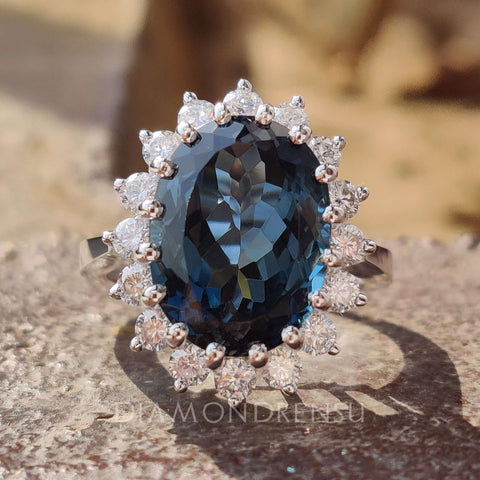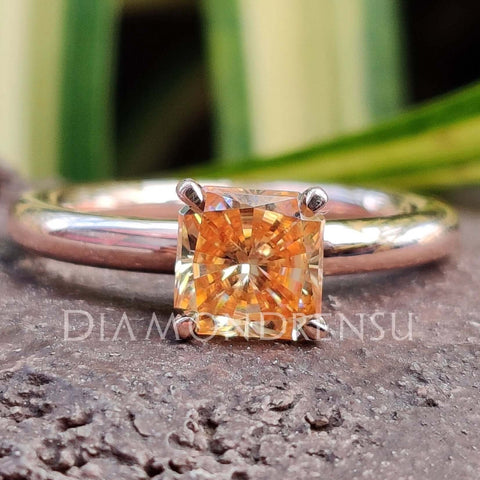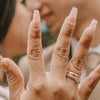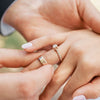
Anatomy of an Engagement Ring: Key Components and Design Elements
An engagement ring symbolizes love, commitment, and the promise of a future together. The anatomy of an engagement ring consists of various components, each with its own significance and purpose. Understanding these elements not only adds to the appreciation of the ring's beauty but also aids in making informed decisions when selecting or customizing the perfect engagement ring.
The three primary parts of an engagement ring are the band, the setting, and the center stone. The band, typically made from precious metals like gold, platinum, or silver, wraps around the finger and provides the foundation for the ring's design. The setting, often referred to as the head, secures the center stone in place while enhancing its overall appearance. The center stone, usually a diamond or other precious gem, serves as the focal point and is often surrounded by smaller accent stones to add brilliance and sparkle.
When choosing an engagement ring, understanding the anatomy becomes crucial, as it allows individuals to make educated decisions regarding the balance between style, durability, and cost. By delving into the components of the ring, couples can select a unique and meaningful design that celebrates their love and represents the beginning of their lifelong journey together.
Understanding the Anatomy

| Part | Description |
|---|---|
| Center Stone | The main gemstone, typically a diamond, that is the focal point of the ring. |
| Prongs | Thin metal claws that hold the center stone securely in place. |
| Setting | The metal framework that holds the center stone and secures it to the band. |
| Band | The circular part of the ring that goes around the finger and can vary in width and design. |
| Shank | The lower part of the band that sits below the center stone and can also have decorative elements. |
| Gallery | The area beneath the center stone where the prongs and setting meet the band; may include intricate details. |
| Shoulders | The upper part of the band that leads up to the center stone; can have accent stones or embellishments. |
Band
The band is an essential component of an engagement ring. It encircles the wearer's finger and serves as the foundation for the ring's design. Often made from precious metals such as gold, silver, or platinum, bands come in various styles, like plain, engraved, or even intricate filigree designs. The engagement ring band is a reflection of the wearer's personal style and taste.
Shank
The shank refers to the part of the engagement ring that extends from the band to the shoulder. It is responsible for providing balance and stability to the ring, ensuring that the head and the gemstone stay firmly, yet comfortably, in place. Different styles of shanks offer different levels of support and aesthetics, such as flat, tapered, or split shank designs.
Shoulder
The shoulder of an engagement ring bridges the gap between the shank and the head, often featuring intricate designs or additional accent stones. It helps elevate the ring's central gemstone and adds visual interest to the overall design. The shoulder's style and detailing can vary significantly, from simple and minimalist to ornate and elaborate, depending on the wearer's preference.
Head
Arguably the most crucial part of any engagement ring, the head holds the central gemstone securely in place. It can vary in appearance, depending on the type of settings used, such as prong, bezel, or halo settings. The head also determines the height and prominence of the central gemstone, affecting the ring's overall profile and appearance.
Precious Metal
The choice of precious metal for an engagement ring significantly impacts its appearance and durability. Gold, platinum, and silver are the most commonly used materials for crafting engagement rings. Each of these metals has its distinct benefits and characteristics. Gold, for example, can come in yellow, white, or rose, and is often alloyed with other metals to enhance strength and color.
Platinum, on the other hand, is a naturally white metal, with impressive durability and hypoallergenic properties. Silver offers an affordable and versatile option, though it requires more maintenance due to its tarnish-prone nature. Ultimately, the choice of precious metal should complement the ring's overall design and aesthetics, as well as the wearer's lifestyle and preferences, such as Diamondrensu's designer Moissanite engagement rings.
All about Diamonds

Center Stone
The center stone is the focal point of an engagement ring and often the most valuable. It can be a lab-grown diamond or a natural diamond. The center stone's size, shape, and quality significantly impact the ring's overall appearance and value.
Side Stones
Side stones are smaller diamonds that complement the center stone, enhancing its beauty and adding balance to the ring design. They can be the same shape as the center stone or a different one to create contrast. Popular side stone shapes include oval, pear, and emerald.
Accent Stones
Accent stones are even smaller diamonds placed around the center and side stones to add extra sparkle and detail. They can be pave set, channel set, or bezel set, and are usually round or baguette-shaped. Accent stones can also be arranged in various patterns to create a unique look.
Diamond Shape

There are several diamond shapes to choose from, each with its characteristics and aesthetics. Some popular diamond shapes for engagement rings are:
- Oval: An elongated shape that offers a larger surface area, making the diamond appear bigger.
- Pear: A teardrop-shaped diamond with one rounded end and one pointed end, creating an elegant look.
- Emerald: A rectangular shape with step-cut facets that showcase the diamond's clarity and create a sophisticated, vintage vibe.
When selecting a diamond shape, consider the wearer's personal style and preferences, as well as how the shape will complement the ring's overall design.
Understanding Settings
Prong
The prong setting is one of the most classic and popular styles for engagement rings, primarily because it highlights the center stone in a simple yet elegant manner. In this type of setting, the diamond is held in place by metal prongs or claws that extend from the band. Prong settings can feature different numbers of prongs, with four and six being the most common choices.
Bezel
A bezel setting is characterized by a metal rim that surrounds and securely holds the gemstone in place. This type of setting provides additional protection for the stone, making it an excellent choice for those with active lifestyles. The bezel setting's sleek and modern appearance can also give a contemporary flair to the engagement ring design.
Pavé
Pavé settings, which derive their name from the French word for "paved," involve the use of many small diamonds set close together, creating a continuous surface of sparkle on the band. This style of setting can be seen in lab-created diamond halo engagement rings, as it often complements a larger center stone by adding extra brilliance and texture.
Halo
Halo settings feature a center stone encircled by a ring of smaller diamonds or gemstones. This design not only accentuates the size and brilliance of the main stone but also adds a sophisticated and glamorous touch to the engagement ring. Halos can be single or double, with each offering a distinct look and feel.
Three-Stone
Three-stone settings, as the name suggests, include a center stone flanked by two additional stones on either side. This setting symbolizes the past, present, and future of a couple's relationship, making it a romantic and meaningful choice for an engagement ring. The side stones can be matching or contrasting to the main stone, allowing for various creative design options.
Identifying Different Designs
When it comes to engagement rings, there are several popular designs that cater to different tastes and preferences. In this section, we'll discuss four classic styles: Solitaire, Three Stone, Split Shank, and Eternity Band.
Solitaire
A solitaire design is often considered the most timeless and elegant option for an engagement ring. This style features a single center stone, which can be any shape, including round, princess, and even pear cut. The simplicity of the solitaire design highlights the beauty of the chosen gemstone while maintaining a clean, understated look. To enhance the center stone, consider adding a delicate band or incorporating small accent stones along the band.
Three Stone
The three stone engagement ring is symbolic and romantic, representing a couple's past, present, and future together. This design includes a center stone flanked by two smaller side stones. Often, these additional stones are the same shape as the center stone, but they can also be different. For example, a round center stone might be complemented by pear or marquise-shaped side stones. The three stone design is versatile and allows for various combinations of gemstones and settings.
Split Shank
Split shank engagement rings provide a unique and eye-catching design, featuring a band that visually splits into two parts as it approaches the center stone. This design creates the illusion of a larger center stone and adds an artful twist to the traditional solitaire or three stone ring. Split shank rings can be customized with various band styles, such as pave-set diamonds or twisted metalwork.
Eternity Band
Eternity bands offer a symbol of everlasting love and commitment, as they feature a continuous circle of gemstones that encompasses the entire band. Often used as wedding bands, they can also serve as stunning engagement rings, particularly for those who appreciate minimalism and symmetry. The gemstones in eternity bands can be all diamonds or a combination of diamonds and other precious stones, such as sapphires or rubies. Keep in mind that because the stones encircle the entire band, sizing and resizing may be more complex for eternity bands compared to other designs.
Other Ring Components
Sizing Area
The sizing area is the part of the ring that can be altered for adjustments in fit. It is situated at the bottom or inner part of the band, and is essential for ensuring proper comfort and grip on the wearer's finger.
Crown
The crown refers to the top section of the ring which supports and showcases the center stone or main design element. It adds prominence to the ring and enhances the overall appearance. When choosing moissanite jewelry, pay attention to the crown design, as it can make a significant impact.
Hallmark
A hallmark is an official stamp or mark found on a piece of jewelry, signifying the metal's purity. Often placed in an inconspicuous spot on the ring, it provides assurance about the quality and authenticity of the materials used.
Mounting
The mounting component secures the gemstones or main design elements in place on the ring. It ensures the stones are held securely while allowing them to be showcased beautifully. Mountings can vary in style and complexity, depending on the design choices.
Gallery
The gallery is the part of the ring below the crown, which connects the shank or band to the head. It is often adorned with intricate details or additional stones, adding a unique touch and visual appeal to the ring's design.
Bridge
Lastly, the bridge is a supportive structure that connects the ring's shoulders or shank across the bottom of the gallery. It provides stability, ensuring the engagement ring is durable and built to last.
Customizing Your Ring

Personalized Service
When it comes to creating a unique engagement ring, personalized service is essential. High-quality jewelers will work closely with customers to ensure they understand their preferences and style. This level of personalized attention allows customers to create a one-of-a-kind ring that truly represents their relationship and commitment. One company that offers such a unique service is Diamondrensu, where shoppers can explore custom moissanite wedding bands, earrings, rings, and more online.
Ring Design
There are numerous design elements to consider when customizing an engagement ring. Some couples prefer a modern and sleek design, while others may lean towards classic and traditional styles. Here are some key aspects to consider when creating a bespoke engagement ring:
-
Band material: Choose from a variety of precious metals, such as gold, platinum, or silver, to match your partner's taste and ensure durability.
-
Gemstone choice: Select a center stone that reflects your partner's personality and preference. Moissanite, for example, offers a beautiful and brilliant alternative to traditional diamonds.
-
Setting style: The way the gemstone is mounted on the ring can impact its overall appearance. Options include prong, bezel, or tension settings, among others.
-
Engravings and side stones: To add an extra touch of personalization, engrave meaningful words or symbols on the ring or include additional stones to accent the center gem.
Remember, the key to a successful ring customization process is working with a knowledgeable jeweler who can guide you through each step, ensuring that the final product is a beautiful reflection of your love and commitment.
The Perfect Pair
When it comes to celebrating the union of two people, the engagement ring and wedding band play an essential role in symbolizing their love and commitment. The perfect pair of rings not only complements each other aesthetically but also represents the couple's unique journey and taste.
Engagement and Wedding Band
Engagement rings, traditionally gifted to propose marriage, are a symbol of promise and love, usually adorned with precious stones, like lab grown diamonds. On the other hand, wedding bands symbolize the eternal bond of marriage and are often simpler, with a continuous circular shape representing never-ending unity.
When selecting the perfect pair of engagement and wedding rings, several factors should be considered:
- Design: Ensure both the engagement and wedding band complement each other in terms of shape, style, and metal type.
- Fit: The rings must fit comfortably, considering that most couples wear their wedding bands daily.
- Personal style: Choose the pair that best reflects the couple's preferences, emotions, and story.
The matching of engagement rings and wedding bands can be achieved in various ways. Some couples prefer an interlocking design, where the rings fit together seamlessly, while others opt for coordinating elements, like similar metal types or gemstones.
With a confident, knowledgeable, neutral, and clear approach, finding the perfect pair of engagement and wedding rings becomes a beautiful and meaningful journey that a couple embarks on. By keeping in mind the significance of the rings and the loving union they symbolize, the right pair will undoubtedly add a touch of magic to a couple's special day.
Considerations in Choosing an Engagement Ring

When selecting an engagement ring, one must consider the type of jewelry and the precious metal that suits their tastes and the recipient's preferences. A popular option is the diamond ring, often characterized by its brilliant sparkle and timeless beauty. One classic design is the solitaire setting, in which a single stone takes center stage.
The solitaire setting can come in various designs, such as the basket, which holds the gemstone in a metal frame. This design offers a delicate, yet secure hold on the stone, allowing light to pass through and increase the brilliance of the gem. Other designs may focus on unique elements or be created by a renowned designer, providing a distinct touch to the engagement ring.
In addition to diamonds, couples may also consider alternative gemstones, adding a unique and personal flair to the engagement ring. Gemstones can vary in color, size, and clarity, allowing for endless customization and making each ring a one-of-a-kind creation.
The precious metal used in the ring should also be taken into account. Gold, silver, and platinum are common choices, and each has its unique characteristics in terms of durability, appearance, and value. It's essential to consider the metal type that will best suit the wearer's lifestyle, daily activities, and personal preferences.
In conclusion, to ensure that the engagement ring meets the couple's expectations, it's crucial to consider various factors, including the type of jewelry, precious metal, gemstone, and setting design. With these considerations in mind, the ring selected will truly reflect the love and commitment shared between the two.
Frequently Asked Questions
What are the main parts of an engagement ring?
An engagement ring typically consists of three main parts: the center stone, the setting, and the band. The center stone is usually a diamond, but alternative gemstones like sapphires, emeralds, or rubies can also be chosen. The setting is the metal framework that holds the center stone in place. Lastly, the band is the part of the ring that goes around the finger, often referred to as the shank.
How can I choose the right shank style?
Selecting the right shank style depends on personal preference, style, and budget. Popular shank styles include the classic single shank, which is a simple continuous band. A split shank features two bands that split apart from each other, showcasing the center stone. Pave shanks have small diamonds embedded along the band for extra sparkle. Lastly, intricate designs or engraving can also be incorporated into the shank to further personalize the ring.
What are popular gallery designs?
The gallery, also known as the profile, is the side view of the engagement ring and can feature various designs. Some popular gallery styles include a cathedral setting, which raises the center stone, creating a dramatic profile. A basket setting allows for a more intricate design, while a trellis setting intertwines the prongs for added support and a unique look. The choice of gallery design is subjective and should be chosen to suit the wearer's aesthetic preferences.
What is the role of a hidden halo in a ring?
A hidden halo is a design feature in which small diamonds encircle the base of the center stone, creating a subtle yet additional sparkle. This feature is not visible when looking straight down at the ring, giving the appearance of a floating center stone. The hidden halo can add a touch of extra glamour to an engagement ring without being too overpowering.
How are diamonds secured in an engagement ring?
Diamonds can be secured in an engagement ring using various techniques, such as prongs, bezel, tension, and channel settings. Prong settings use small metal claws to hold the center stone in place, while bezel settings encase the entire edge of the diamond in metal. Tension settings hold the diamond with pressure between the metal bands, and channel settings secure small diamonds by embedding them in a grooved channel along the band.
What factors to consider when selecting an engagement ring?
When selecting an engagement ring, consider the wearer's lifestyle, personal style, and budget. Begin by selecting a center stone, considering shape, size, and type of gemstone. Next, choose the metal for the setting, taking into account durability, color preference, and maintenance. Lastly, consider additional design elements such as shank style, gallery design, and any hidden features like a hidden halo. Remember that the most important factor is to choose an engagement ring that reflects the unique personality and style of the person wearing it.
Checkout some of our top collections:
Leave a comment
Please note, comments must be approved before they are published.














